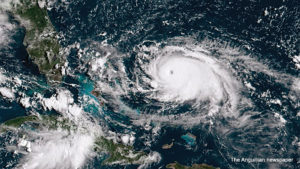
Taking into account the close coordinates and proximity that Dorian was to Anguilla, in its early stage as a tropical storm, and then became a hurricane, how prepared were we for that possible eventuality?
Dorian developed into a category five hurricane and pounded The Bahamas for some three days, travelling at one mile per hour and then three. The powerful hurricane could have taken a swipe at Anguilla had it not been so far south or south-west at the time of its approach across other islands including St. Thomas.
The question really to be asked is: How prepared were we in Anguilla if the intense hurricane had hit us, while we are still recovering from Hurricane Irma?
In a general interview on Tuesday, September 3, The Anguillian put this question to His Excellency the Governor, Mr. Tim Foy, OBE, whose office has responsibility for Disaster Preparedness and Management.
“I am glad you raised the question,” he replied. “I think we are in a much better place than we certainly were in September 2017. We are probably in a much stronger position than we had been. Irma taught us a lot of lessons. In terms of preparations by the Disaster Management Committee, and the National Emergency Operations Centre, our position has been really strengthened; and the communications equipment in the National Emergency is as good as you can get anywhere in the world.
“In terms of businesses, I think that petrol and communications companies know what they are doing; and I am very confident that they continue to strengthen their preparations.
“The truth is that we still have a lot of infrastructure that is not rebuilt. The secondary school is still on a shift system so we just have one main building – Campus B. That leaves us very vulnerable and that’s why getting on with the reconstruction work is so important. We would be vulnerable, but I think our preparations would be much better than they were in 2017.
“I can tell you that the Foreign Office has a contract in place with the Canadian Company – Linesman – so that we would be able to restore power even quicker than we managed to do in 2017.
“There has been a lot of thought going into preparation and immediate response. But I never want to test those preparations ever again. I have had my fill of tropical storms and hurricanes.”
Governor Foy continued: “I really commend the National Disaster Management Team – and all our principal responders like the police and firemen; and all the tremendous amount of work that was put into the hospital to make it so much more resilient. But I am not going to be dishonest to say everything is fine until we get our schools, the House of Assembly and other projects fixed. However, we are in a much better position.”
With some changes in Disaster Management, the Governor was asked whether his office had assumed more responsibility following Irma. “Constitutionally, the Governor is responsible for Disaster Preparedness,” he answered. “Scarred by Irma, I take a keen interest in that, and I expect that people will want me to do that – and so we keep a very positive working relationship. It is not scrutiny. The people there don’t need scrutiny. They know what to do and what they are doing. I am more interested in finding what I can do to help them; what additional resources they need to fix a particular issue; what additional training they would like; and when I can put them in touch with colleagues in another Overseas Territory.
“I have to say that the Overseas Territories, as a group, and the Organisation of Eastern Caribbean States, as a group, are working really well on hurricane preparedness. Everybody shares the same problems and I think everybody in Anguilla is thinking about their kinfolk in The Bahamas who suffered so tragically at the hands of a ‘cat-5’which we did suffer; but it was one that didn’t move at 15 or 20 miles an hour but stayed there in The Bahamas at one mile-an-hour wreaking havoc. We were blessed.”







